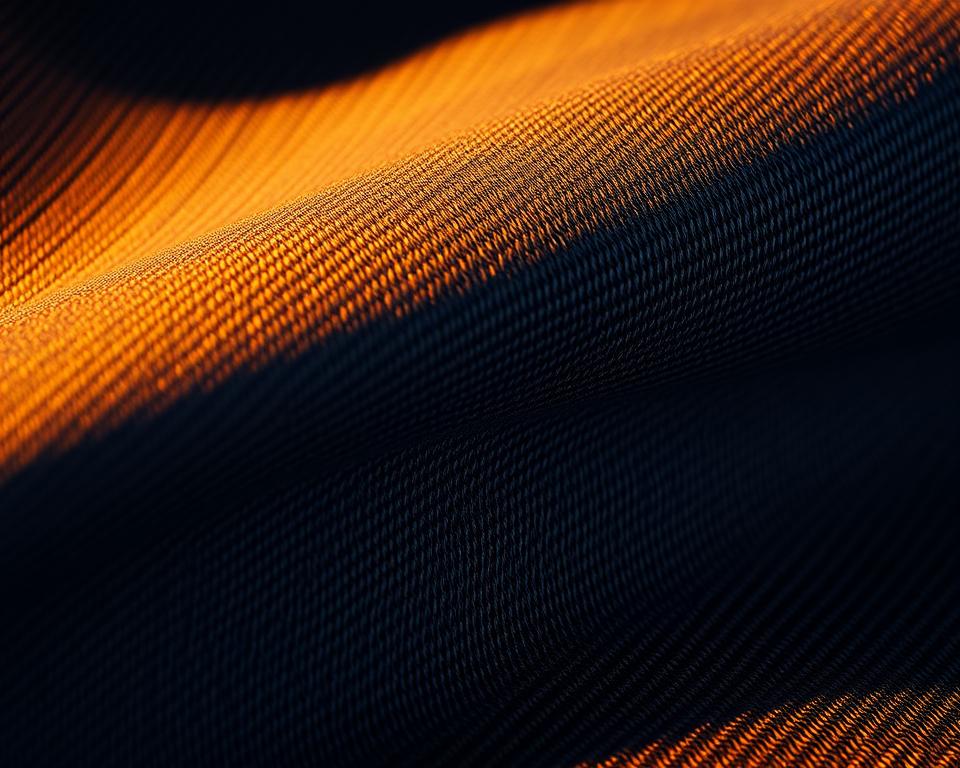A Comprehensive Manual to High-Quality denim Selvedge Fabric
Ever pondered why certain pants seem like they’re made to last eternity? Everything revolves around the materials and skill. Consider the rising trend of premium selvedge. This goes beyond common material—it attests to quality and legacy.
Currently, a growing number of people are choosing these everlasting textiles for their robustness and traditional ewingfly denim appeal. Be it that you are a do-it-yourself sewist or a denim aficionado, there’s a unique quality about using top-grade natural fiber and yarn. It’s not just about constructing trousers; it’s about producing a narrative.
At Core Fabrics, we’ve assembled a collection of 14.25oz eco-friendly cotton and flexible choices. These materials are ideal for all from raw trousers to designer jacket patterns. Prepared to dive into the world of top-tier fabrics? Let’s jump right in.
What Is Denim Selvedge Fabric?
What is it that makes some jeans stand out with their distinctive, naturally edged edges? The key resides in the selvedge denim, a high-quality material renowned for its durability and vintage aesthetic. In contrast to standard textiles, such material is fashioned with traditional methods that have proven their worth.
The Definition of Selvedge Denim
Selvedge denim is manufactured using retro shuttle looms, which generate narrow widths of about 30-35 inches. The looms interlace the material in a way that creates self-finished borders, often accented with a distinctive red line. This method confirms the fabric is densely interlaced and exceptionally sturdy.
Current looms, alternatively, produce expansive textile but fall short of the same level of craftsmanship. The imperfections in selvedge, like misaligned seams or inconsistent patterns, are embraced as elements of its beauty. This philosophy, often referred to as “wabi-sabi”, celebrates the appeal of organic flaws.
The Making of Selvedge Denim
The manufacturing of selvedge denim involves a exacting process. These looms interlace the filling yarns in alternating directions, creating a thick and resilient textile. Unlike modern methods with modern looms, which emphasize speed and efficiency over quality.
Labels such as Karson Denim uphold traditional Japanese craft practices from the 90s. They deliberately incorporate anomalies to retain the genuineness of the material. Every item is evaluated on a four-point system, ensuring it satisfies the peak requirements of excellence.
| Characteristic | Selvedge Denim | Modern Denim |
|---|---|---|
| Span | 30-35 inches | 60+ inches |
| Weaving Process | Shuttle Loom | Modern Loom |
| Finish | Irregular, Flawed | Consistent |
| Sturdiness | High | Moderate |
“The allure of selvedge lies in its imperfections—every imperfection narrates a tale artistry and heritage.”
The Background of Selvedge Denim
From humble beginnings to global acclaim, the tale of these materials is multifaceted and moving. Originally developed as durable workwear in seventeenth-century France evolved into a mark of timeless style and craftsmanship.
Historical Roots
The roots of this textile dates back to Nîmes, France, where it was known as “serge de Nîmes.” Initially created for workers, it was made from sturdy cotton and yarn. Its durability made it a favorite among laborers during the Gold Rush.
By the 20th century, it had become a cornerstone for jeans. The ending of the Cone Mills White Oak facility marked a turning point. This transition paved the way for Japanese artisans to restore old-world weaving methods.

Advancements in Production
Following WWII, Japan adopted retro American culture. Artisans restored classic looms to create genuine reproductions. This dedication to craftsmanship ensured the continuance of selvedge as a niche product.
Currently, innovations from Italy and Turkey have introduced sustainable blends and stretch selections. These improvements have widened the attraction of this timeless material. Within Core Fabrics, we gather worldwide, from Montréal to Asia, to bring you the best quality.
“Selvedge’s story is a celebration of the enduring value of craftsmanship and legacy.”
The Benefits of Selvedge Denim?
What makes selvedge denim shine in the world of superior fabrics? Its unique qualities and exceptional longevity render it popular among lovers and creatives alike. Whether you’re crafting pants or a structured jacket, this material provides a fusion of heritage and updated style.
Distinctive Attributes of Selvedge
Selvedge denim is renowned for its tight weave, which improves ripping resistance and color fading characteristics. In contrast to common fabrics, denim selvedge fabric is fashioned using classic shuttle looms, creating a more compact and exceptionally sturdy material. Such a process guarantees that every item possesses a distinct surface and individuality.
Notable attributes are:
- Coarse, stiff raw denim contrasts with softened, pre-washed stretch fabrics.
- Sanforization stabilizes the fabric for consistent measurements, while natural variants entail a shrink-to-fit adventure.
- Available weights span from 9.5oz Eco Finish to 14.25oz Organic, meeting diverse applications.
Durability and Longevity
One of the standout features of selvedge denim is its enduring nature. The tighter weave not only increases durability but also allows for characteristic wear patterns over time. This renders it a treasured choice for those in pursuit of enduring style.
Main considerations:
- Fabrics weighing between 12oz and 14oz are perfect for form-fitting jackets and jeans that mellow with time.
- The 14.25oz True Indigo option is highly favored for enduring jeans.
- Green alternatives, including recycled cotton with indigo blends, contribute to a sustainable collection.
Within our range at Core Fabrics, diverse choices cater to distinct demands. Spanning from raw finishes to sanforized treatments, each selection is designed for superior quality and value.
Comparing Selvedge and Wide Denim
For making durable and stylish garments, the selection of fabric is pivotal. Two common choices include selvedge and wide denim, both offering different features. Knowing how they differ assists in selecting the right one for your project.
Key Differences in Weaving Techniques
Selvedge denim is woven on traditional shuttle looms, yielding narrow widths of 30-35 inches. This herringbone denim material technique creates firm borders, often marked by a distinctive red line. In contrast, wide denim is produced using modern projectile looms, yielding expansive widths of over 60 inches.
Traditional shuttle looms operate at approximately 3 meters per minute, while projectile looms can produce up to 30 meters per minute. Such speed differences influence both the expense and the surface quality of the outcome.
Advantages and Disadvantages
Selvedge denim is known for its premium quality and durability. Its limited breadth suits it well for projects where defined edges and detail work are sought. However, it can be more expensive, averaging $23 per meter.
Wide denim is more cost-effective, ranging at $8 per half-meter. Its broader span cuts down on scrap, well-suited to extensive endeavors like furniture covering. However, it does not feature the unique edge finish of selvedge.
| Characteristic | Selvedge Denim | Wide Denim |
|---|---|---|
| Span | 30-35 inches | 60+ inches |
| Method | Traditional Shuttle | Projectile Loom |
| Production Speed | 3 meters per minute | 30m per minute |
| Cost | $23/meter | $8/half-meter |
For defined borders as seen in Grainline Thayer jackets, selvedge is favored. Conversely, wide denim is ideal for extensive projects due to its efficiency. Consider your project needs to make the best decision.
How to Use Selvedge Denim
Crafting with high-end textiles raises your projects to a new standard. Be it making trousers, jackets, or skirts, understanding the basics of yardage, sewing techniques, and care ensures a professional finish. Let’s explore how to make the most of this timeless fabric.
Material Requirements for Jeans and Jackets
When planning your project, calculating the right amount of material is crucial. Approximately 3-3.3 yards is necessary for men’s jeans, considering defects and shrinkage. Trucker-style jackets generally demand about 3.3 yards, while a skirt often needs 2 yards.
Creative pattern placement can help manage imperfections in the material. Rather than avoiding imperfections, incorporate them into your pattern for distinctive style.
| Garment | Fabric Needed |
|---|---|
| Male Jeans | 3-3.3 yards |
| Work Jacket | 3.3 yards |
| Skirt | 2 yards |
Tips for Sewing and Care
Using the right tools and techniques ensures a polished result. Choose #70 to 110 pins and foot accessories designed for heavy materials. Gütermann rPET thread works well for contrasting stitches.
Additional advice includes:
- Employ a tailor’s clapper to achieve crisp creases without gloss.
- Core Fabrics provides denim kits with topstitch thread, rivets, and 9mm buttons for that expert touch.
- When sturdy borders are needed, such as in jackets, selvedge is optimal.
Proper care extends the life of your creations. Wash sparingly and air dry to maintain the material’s integrity. Adhering to these practices will sustain your creations for years.
The Final Word
Working with high-end textiles is not solely about longevity; it’s about infusing character. Selvedge denim exemplifies this philosophy, merging handcrafted appeal with long-lasting quality. Whether you’re sewing jeans or a structured jacket, this material tells a story with every stitch.
Core Fabrics simplifies your creative journey. Try our swatch service to feel the texture and weight before committing. Plus, enjoy free shipping on orders over $150 USD across North America.
Looking ahead, eco-friendly blends and vintage washes are shaping the future of cotton textiles. These trends offer new ways to add sustainability and style to your wardrobe.
Ready to dive into the world of premium materials? Begin your journey now and appreciate the merit of intentional crafting. Your subsequent creation may well become an enduring classic.

